Charles E W Bean, Diaries, AWM38 3DRL 606/264/1 - 1914 - 1938 - Part 14
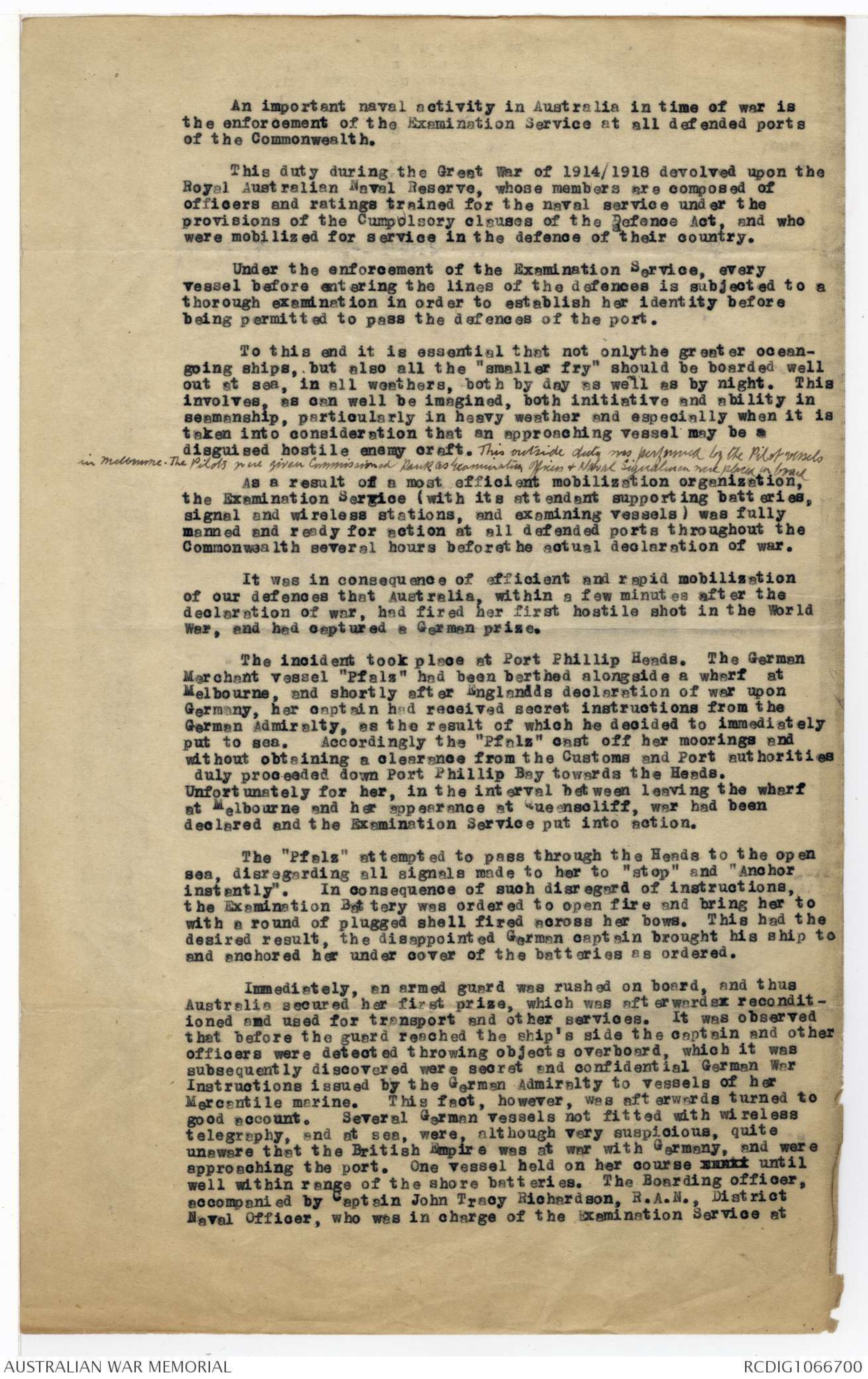
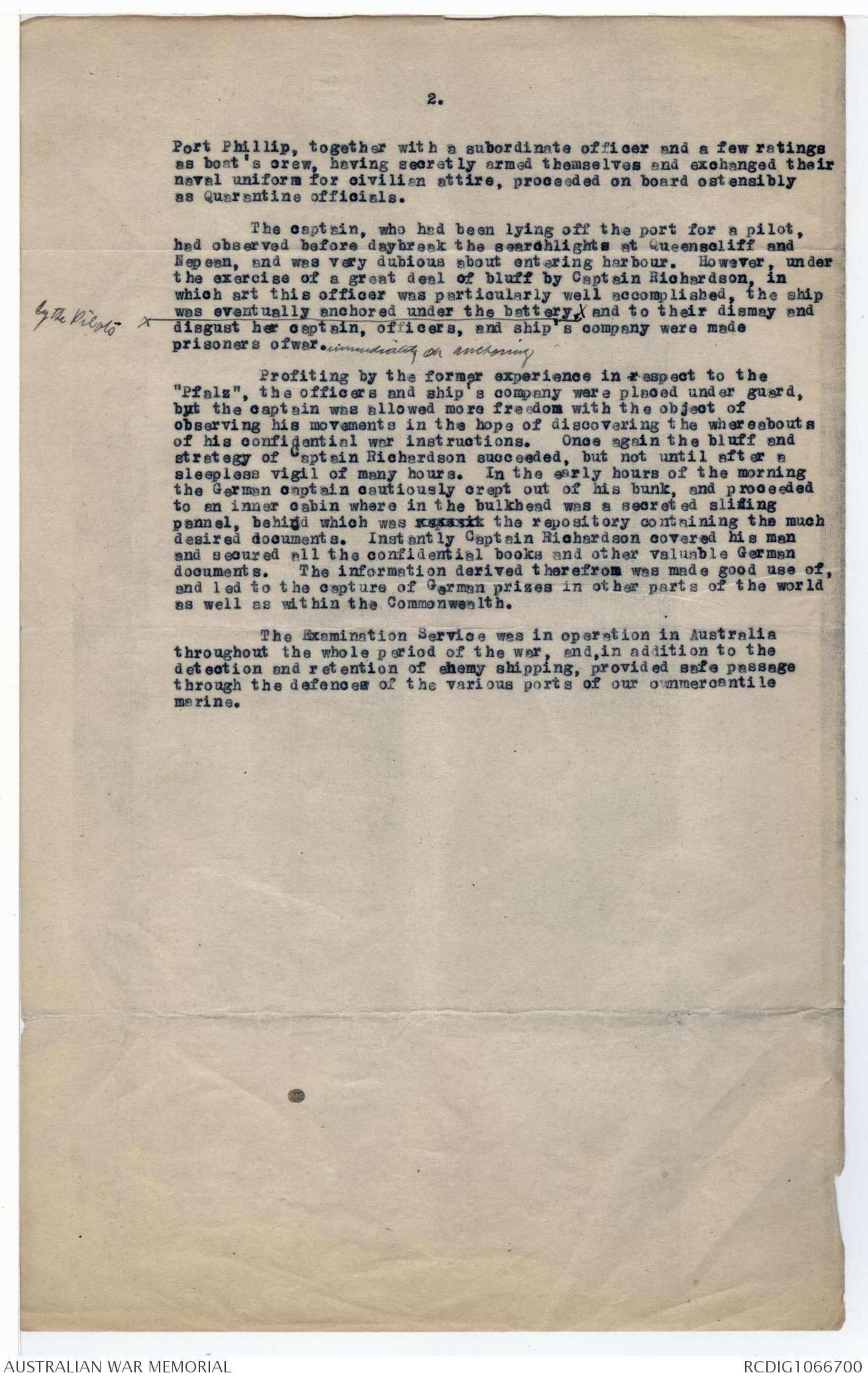
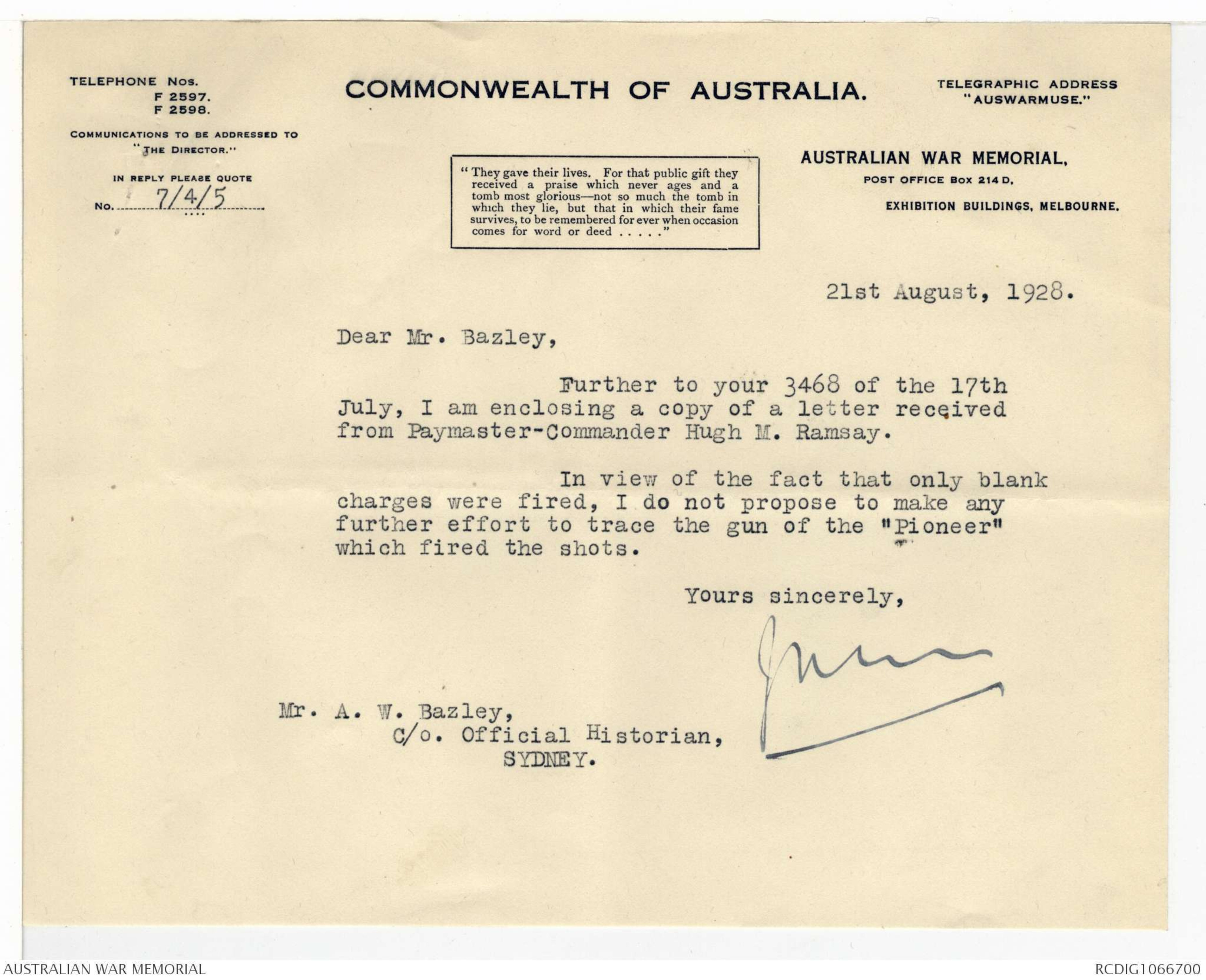
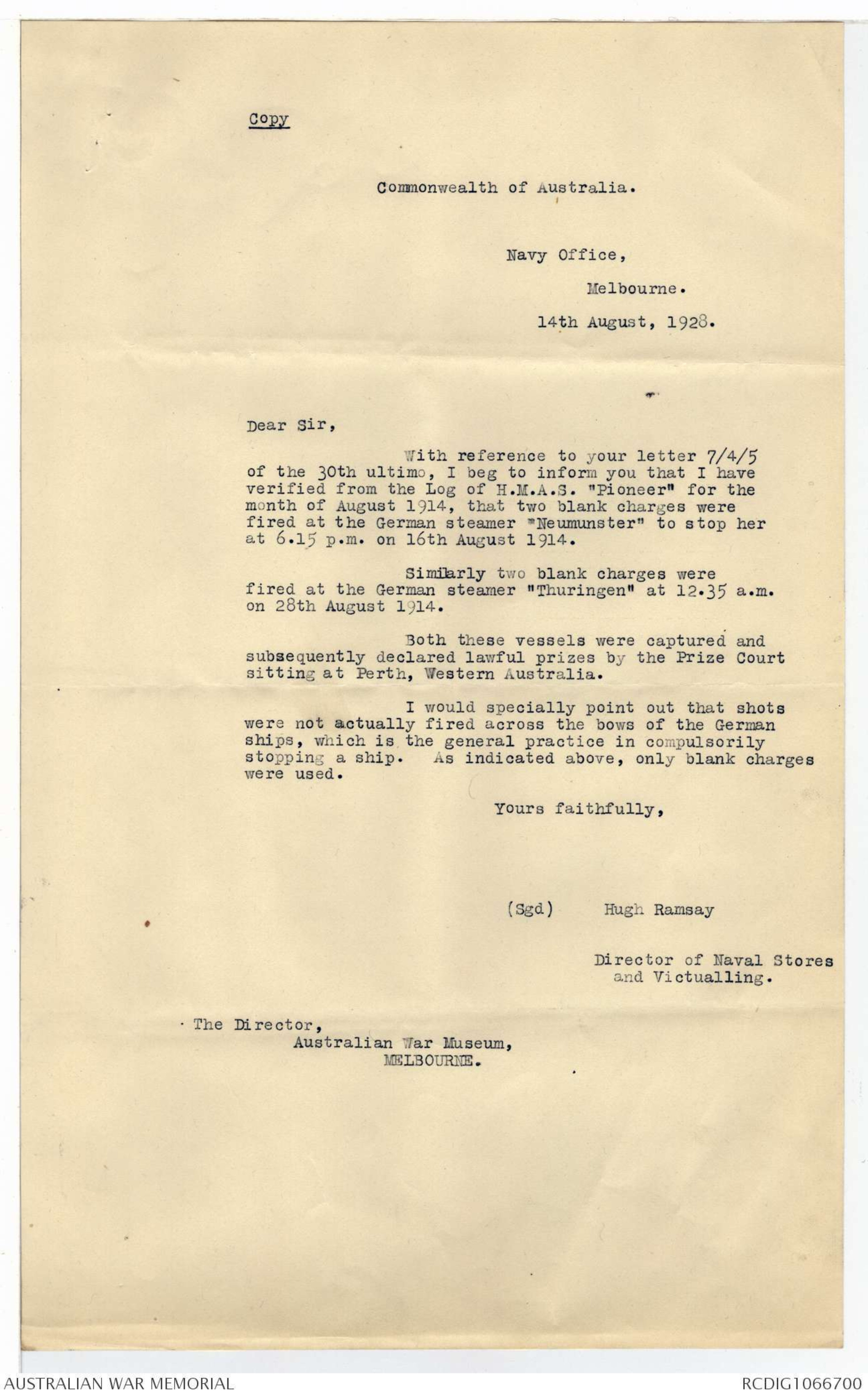
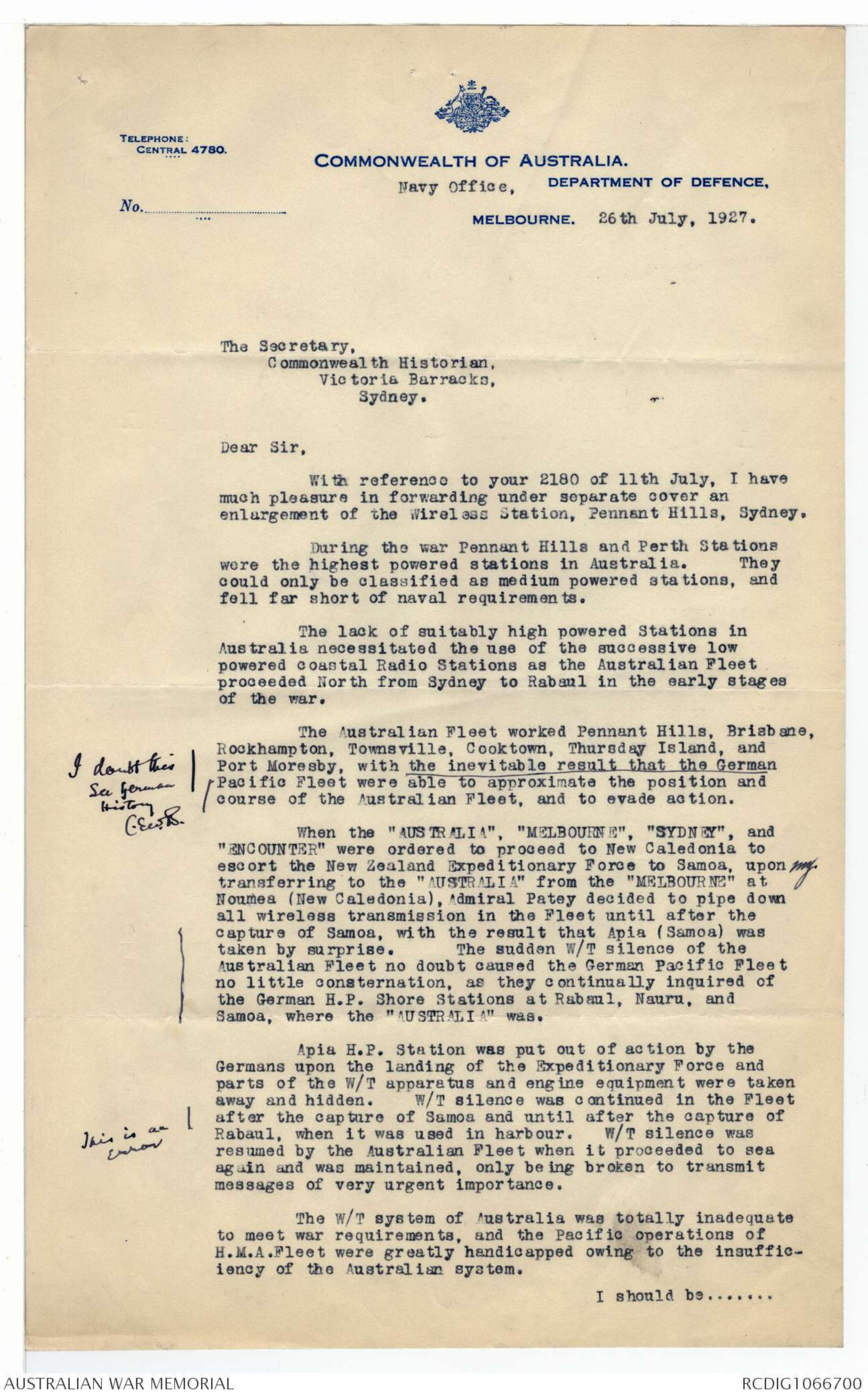
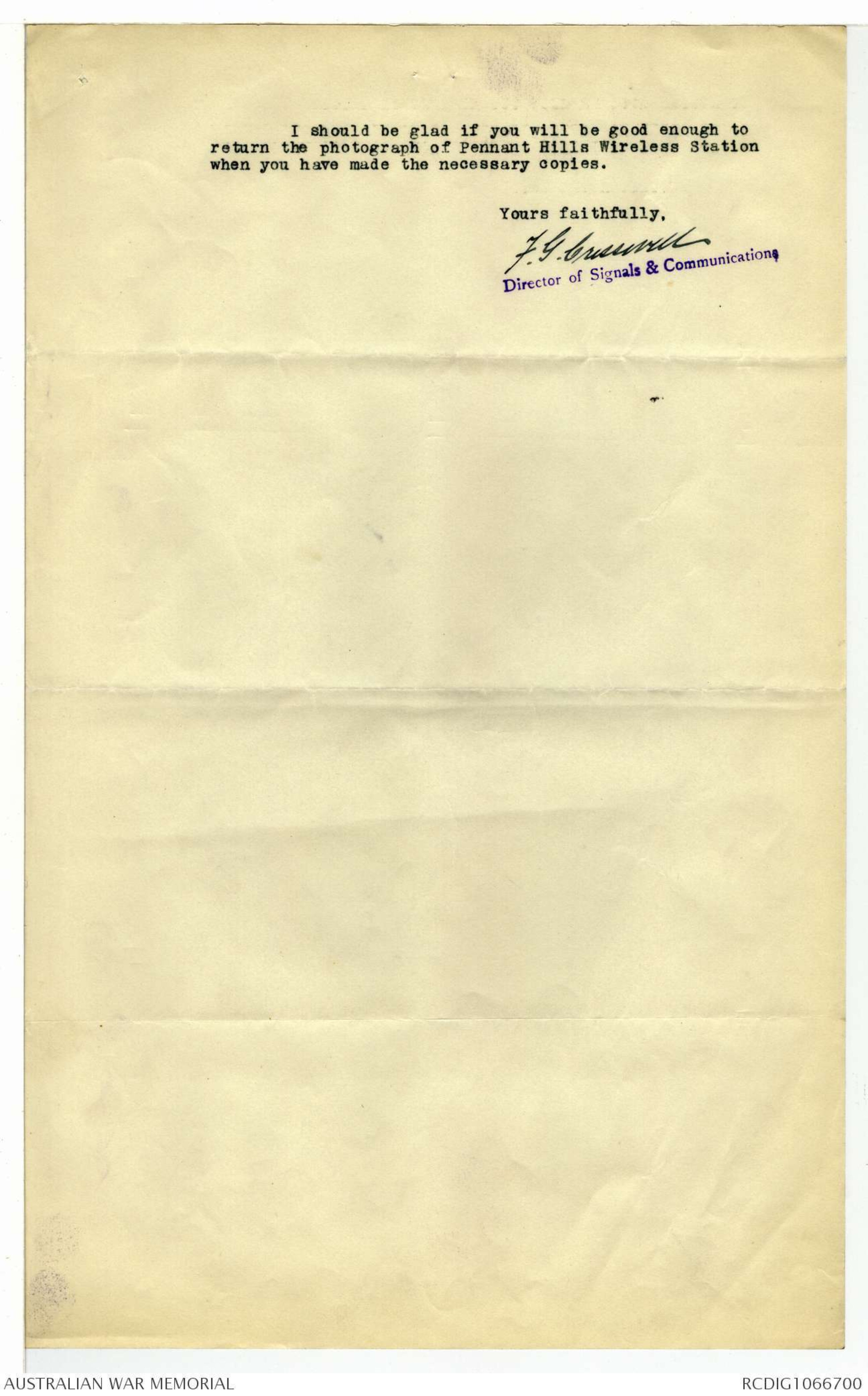

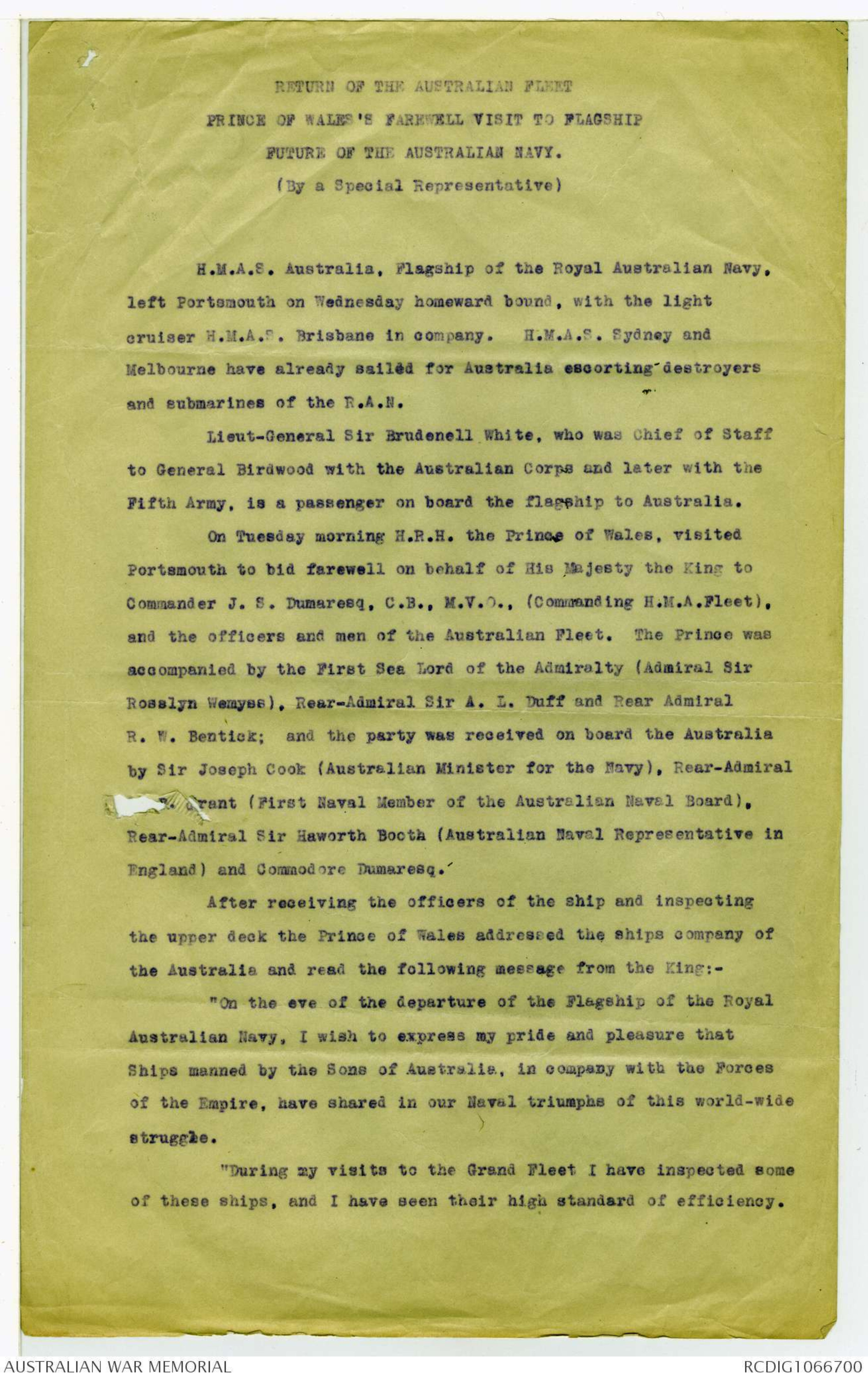


An important naval activity in Australia in time of war is
the enforcement of the Examination Service at all defended ports
of the Commonwealth.
This duty during the Great War of 1914/1918 devolved upon the
Royal Australian Naval Reserve, whose members are composed of
officers and ratings trained for the naval service under the
provisions of the Compulsory clauses of the Defence Act, and who
were mobilized for service in the defence of their country.
Under the enforcement of the Examination Service, every
vessel before entering the lines of the defences is subjected to a
thorough examination in order to establish her identity before
being permitted to pass the defences of the port.
To this end it is essential that not onlythe greater ocean-going
ships, but also all the "smaller fry” should be boarded well
out at sea, in all weathers, both by day as well as by night. This
involves, as can well be imagined, both initiative and ability in
seamanship, particularly in heavy weather and especially when it is
taken into consideration that an approaching vessel may be a
disguised hostile enemy craft.
[*This outside duty was performed by the Pilot vessels
in Melbourne. The Pilots were given Commissioned Rank as Examination Officers & Naval Signalsmen were placed on board.*]
As a result of a most efficient mobilization organization,
the Examination Service (with its attendant supporting batteries,
signal and wireless stations, and examining vessels) was fully
manned and ready for action at all defended ports throughout the
Commonwealth several hours before the actual declaration of war.
It was in consequence of efficient and rapid mobilization
of our defences that Australia, within a few minutes after the
declaration of war, had fired her first hostile shot in the World
War, and had captured a German prize.
The incident took place at Port Phillip Heads. The German
Merchant vessel "Pfalz" had been berthed alongside a wharf at
Melbourne, and shortly after England's declaration of war upon
Germany, her captain had received secret instructions from the
German Admiralty, as the result of which he decided to immediately
put to sea. Accordingly the "Pfalz" cast off her moorings and
without obtaining a clearance from the Customs and Port authorities
duly proceeded down Port Phillip Bay towards the Heads.
Unfortunately for her, in the interval between leaving the wharf
at Melbourne and her appearance at Queenscliff, war had been
declared and the Examination Service put into action.
The "Pfalz" attempted to pass through the Heads to the open
sea, disregarding all signals made to her to "stop" and "Anchor
instantly”. In consequence of such disregard of instructions,
the Examination Battery was ordered to open fire and bring her to
with a round of plugged shell fired across her bows. This had the
desired result, the disappointed German captain brought his ship to
and anchored her under cover of the batteries as ordered.
Immediately, an armed guard was rushed on board, and thus
Australia secured her first prize, which was afterwardsx reconditioned
and used for transport and other services. It was observed
that before the guard reached the ship's side the captain and other
officers were detected throwing objects overboard, which it was
subsequently discovered were secret and confidential German War
Instructions issued by the German Admiralty to vessels of her
Mercantile marine. This fact, however, was afterwards turned to
good account. Several German vessels not fitted with wireless
telegraphy, and at sea, were, although very suspicious, quite
unaware that the British Empire was at war with Germany, and were
approaching the port. One vessel held on her course xxxxx until
well within range of the shore batteries. The Boarding officer,
accompanied by Captain John Tracy Richardson, R.A.N., District
Naval Officer, who was in charge of the Examination Service at
2.
Port Phillip, together with a subordinate officer and a few ratings
as boat's crew, having secretly armed themselves and exchanged their
naval uniform for civilian attire, proceeded on board ostensibly
as Quarantine officials.
The captain, who had been lying off the port for a pilot,
had observed before daybreak the searchlights at Queenscliff and
Nepean, and was very dubious about entering harbour. However, under
the exercise of a great deal of bluff by Captain Richardson, in
which art this officer was particularly well accomplished, the ship
was eventually anchored under the battery,
[*by the Pilots *]
and to their dismay and
disgust her captain, officers, and ship's company were made
prisoners ofwar.
[*immediately on anchoring*]
Profiting by the former experience in respect to the
"Pfalz", the officers and ship's company were placed under guard,
but the captain was allowed more freedom with the object of
observing his movements in the hope of discovering the whereabouts
of his confidential war instructions. Once again the bluff and
strategy of Captain Richardson succeeded, but not until after a
sleepless vigil of many hours. In the early hours of the morning
the German captain cautiously crept out of his bunk, and proceeded
to an inner cabin where in the bulkhead was a secreted sliding
pannel, behind which was reposit the repository containing the much
desired documents. Instantly Captain Richardson covered his man
and secured all the confidential books and other valuable German
documents. The information derived therefrom was made good use of,
and led to the capture of German prizes in other parts of the world
as well as within the Commonwealth.
The Examination Service was in operation in Australia
throughout the whole period of the war, and, in addition to the
detection and retention of enemy shipping, provided safe passage
through the defences of the various ports of our ownmercantile
marine.
TELEPHONE Nos.
F 2597.
F 2598.
COMMUNICATIONS TO BE ADDRESSED TO
"THE DIRECTOR."
IN REPLY PLEASE QUOTE
No. 7/4/5
COMMONWEALTH OF AUSTRALIA.
TELEGRAPHIC ADDRESS
"AUSWARMUSE."
AUSTRALIAN WAR MEMORIAL,
POST OFFICE BOX 214 D,
EXHIBITION BUILDINGS, MELBOURNE.
"They gave their lives. For that public gift they
received a praise which never ages and a
tomb most glorious—not so much the tomb in
which they lie, but that in which their fame
survives, to be remembered for ever when occasion
comes for word or deed . . . . ."
21st August, 1928.
Dear Mr. Bazley,
Further to your 3468 of the 17th
July, I am enclosing a copy of a letter received
from Paymaster-Commander Hugh M. Ramsay.
In view of the fact that only blank
charges were fired, I do not propose to make any
further effort to trace the gun of the "Pioneer"
which fired the shots.
Yours sincerely,
[[?]]
Mr. A. W. Bazley,
C/o. Official Historian,
SYDNEY.
Copy
Commonwealth of Australia.
Navy Office,
Melbourne.
14th August, 1928.
Dear Sir,
With reference to your letter 7/4/5
of the 30th ultimo, I beg to inform you that I have
verified from the Log of H.M.A.S. "Pioneer" for the
month of August 1914, that two blank charges were
fired at the German steamer "Neumunster" to stop her
at 6.15 p.m. on 16th August 1914.
Similarly two blank charges were
fired at the German steamer "Thuringen" at 12.35 a.m.
on 28th August 1914.
Both these vessels were captured and
subsequently declared lawful prizes by the Prize Court
sitting at Perth, Western Australia.
I would specially point out that shots
were not actually fired across the bows of the German
ships, which is the general practice in compulsorily
stopping a ship. As indicated above, only blank charges
were used.
Yours faithfully,
(Sgd) Hugh Ramsay
Director of Naval Stores
and Victualling.
The Director,
Australian War Museum,
MELBOURNE.
TELEPHONE:
CENTRAL 4780.
No. .....
COMMONWEALTH OF AUSTRALIA.
DEPARTMENT OF DEFENCE,
MELBOURNE.
Navy Office,
26th July, 1927.
The Secretary,
Commonwealth Historian,
Victoria Barracks,
Sydney.
Dear Sir,
With reference to your 2180 of 11th July, I have
much pleasure in forwarding under separate cover an
enlargement of the Wireless Station, Pennant Hills, Sydney.
During the war Pennant Hills and Perth Stations
were the highest powered stations in Australia. They
could only be classified as medium powered stations, and
fell far short of naval requirements.
The lack of suitably high powered Stations in
Australia necessitated the use of the successive low
powered coastal Radio Stations as the Australian Fleet
proceeded North from Sydney to Rabaul in the early stages
of the war.
The Australian Fleet worked Pennant Hills, Brisbane,
Rockhampton, Townsville, Cooktown, Thursday Island, and
Port Moresby, with the inevitable result that the German
Pacific Fleet were able to approximate the position and
course of the Australian Fleet, and to evade action.
[*I doubt this
see German
History
C.E.W.B*]
When the "AUSTRALIA", "MELBOURNE", "SYDNEY", and
"ENCOUNTER" were ordered to proceed to New Caledonia to
escort the New Zealand Expeditionary Force to Samoa, upon my
transferring to the "AUSTRALIA" from the "MELBOURNE" at
Noumea (New Caledonia), Admiral Patey decided to pipe down
all wireless transmission in the Fleet until after the
capture of Samoa, with the result that Apia (Samoa) was
taken by surprise. The sudden W/T silence of the
Australian Fleet no doubt caused the German Pacific Fleet
no little consternation, as they continually inquired of
the German H.P. Shore Stations at Rabaul, Nauru, and
Samoa, where the "AUSTRALIA" was.
Apia H.P. Station was put out of action by the
Germans upon the landing of the Expeditionary Force and
parts of the W/T apparatus and engine equipment were taken
away and hidden. W/T silence was continued in the Fleet
after the capture of Samoa and until after the capture of
[*This is an
error*]
Rabaul, when it was used in harbour. W/T silence was
resumed by the Australian Fleet when it proceeded to sea
again and was maintained, only being broken to transmit
messages of very urgent importance.
The W/T system of Australia was totally inadequate
to meet war requirements, and the Pacific operations of
H.M.A.Fleet were greatly handicapped owing to the insufficiency
of the Australian system.
I should be . . . . . . .
I should be glad if you will be good enough to
return the photograph of Pennant Hills Wireless Station
when you have made the necessary copies.
Yours faithfully,
F.G. Cresswell
Director of Signals & Communications
Copy
COMMONWEALTH OF AUSTRALIA
8126
Commonwealth Offices,
Australia House,
Strand, London,
24th April 1919
MEMORANDUM FOR
The Secretary,
Prime Minister's Department,
Melbourne.
I am directed by the High Commissioner to
forward herewith, for your information, copy of an
article on the subject of the "RETURN OF THE
AUSTRALIAN FLEET", which has been prepared by Mr.
Cutlack of this Office.
Enc.
(sgd) E. A. Box
Official Secretary.
[*Captain Jose
I suppose you have
seen this
[[?]] 20/4/20*]
RETURN OF THE AUSTRALIAN FLEET
PRINCE OF WALES'S FAREWELL VISIT TO FLAGSHIP
FUTURE OF THE AUSTRALIAN NAVY.
[By a Special Representative)
H.M.A.S. Australia, Flagship of the Royal Australian Navy,
left Portsmouth on Wednesday homeward bound, with the light
cruiser H.M.A.S. Brisbane in company. H.M.A.S. Sydney and
Melbourne have already sailed for Australia escorting destroyers
and submarines of the R.A.N.
Lieut-General Sir Brudenell White, who was Chief of Staff
to General Birdwood with the Australian Corps and later with the
Fifth Army, is a passenger on board the flagship to Australia.
On Tuesday morning H.R.H. the Prince of Wales, visited
Portsmouth to bid farewell on behalf of His Majesty the King to
Commander J. S. Dumaresq, C.B., M.V.O., (Commanding H.M.A.Fleet),
and the officers and men of the Australian Fleet. The Prince was
accompanied by the First Sea Lord of the Admiralty (Admiral Sir
Rosslyn Wemyss), Rear-Admiral Sir A. L. Duff and Rear Admiral
R. W. Bentick; and the party was received on board the Australia
by Sir Joseph Cook (Australian Minister for the Navy), Rear-Admiral
[[.?]] Grant (First Naval Member of the Australian Naval Board).
Rear-Admiral Sir Haworth Booth (Australian Naval Representative in
England) and Commodore Dumaresq.
After receiving the officers of the ship and inspecting
the upper deck the Prince of Wales addressed the ships company of
the Australia and read the following message from the King:-
"On the eve of the departure of the Flagship of the Royal
Australian Navy, I wish to express my pride and pleasure that
Ships manned by the Sons of Australia, in company with the Forces
of the Empire, have shared in our Naval triumphs of this world-wide
struggle.
"During my visits to the Grand Fleet I have inspected some
of these ships, and I have seen their high standard of efficiency.
(2)
"In 1914 the pressence of the Battle Cruiser "Australia"
materially checked the enemy's heaviest forces in the Pacific,
at a time when the "Melbourne" and the "Sydney" were convoying
Australian Transports to the seat of war.
"It was the dogged pursuit and the destruction of the
'Emden' that arrested the havoc wrought on our lines of communication.
"I heartily thank the Government and people of Australia
for their generous provision of so valuable a Naval Force, and
I wish to express my gratitude to all ranks and ratings for
faithful and devoted services during the war.
"To all who have sailed, or who are about to sail back
to the Great Commonwealth, I wish God-speed, and a happy return
to their homes and families, from whom they have been so long
separated.
"May they carry with them and hand down to their descendants
the same spirit of kinship and unity that has animated them
throughout the arduous trials from which the Empire has emerged
victorious."
Having read the message, the Prince added:- "I want to
say personally what a real pleasure and privilege it is to me
to be here to-day. I know what splendid work the Australian
Navy has done throughout the war, and how much you have all
helped to maintain our supremacy on the sea both on the Western
front and in Egypt. I was fortunate enough to be for some time
with the Australian Corps. While I was with them I made many
good friends, so I do not feel a stranger among you. I wish
you all a good voyage, a safe return, and the best of luck in
the future."
Sir Joseph Cook (Australian Naval Minister) then addressed
the officers and ship's company and said:- "We count ourselves
extremely fortunate and highly honored by the presence here
today of Your Royal Highness and we beg you to convey with our
humble duty to His Majesty the grateful thanks of all ranks
and ratings for his gracious message. It is another instance
(3)
of His Majesty's profound and cordial interest in the welfare
of the Australian Commonwealth and in all that relates to its
progress and prosperity. Our Navy has been proud to serve
the Empire and our Allies not only as part of the Grand Fleet
in the North Sea, but also in every ocean of the world. In
this way it has fulfilled the purpose of its creation to share
the burdens and sacrifices as well as the privileges of a
great, free Imperial Community. In these days of stress and
danger we have realised in a special way the unity and
indestructibility of an Empire broadbased upon the people's will.
And we would add our firm conviction that never has the Throne
been more strongly rooted in the affections of the people. In
the future development of our Australian section of the
Imperial Fleet our aim will be to make an adequate contribution
to the defensive forces of the Empire as the best guarantee of
the peace and liberty of the world. We share His Majesty's
hope that "the spirit of kinship and unity" may continue to
animate all sections of the Empire and we shall carry back to
our homes in the Southland with pride and pleasure His Majesty's
message to the Royal Australian Navy."
The Prince then visited H.M.A.S. Brisbane in the Admiral's
barge, and return to the Flagship for luncheon in the Commodore's
state-room.
Before the company left the luncheon table Sir Joseph
Cook made an interesting speech in which he expressed the thanks
of the people of Australia to the Imperial Navy for all the
assistance, and encouragement it had so freely given to the
Australian Navy during the critical times past. Without that
assistance and encouragement Australia could not have done what
she had done. Now the Australian ships were homeward bound
for their own sunny climes. Speaking of those who had worked
for the success of the Australian Navy he said he desired to
mention the Australian Naval Representative in London, Rear-Admiral
Sir Haworth Booth, whose work was very keenly
 Marisa Bortolotto
Marisa BortolottoThis transcription item is now locked to you for editing. To release the lock either Save your changes or Cancel.
This lock will be automatically released after 60 minutes of inactivity.